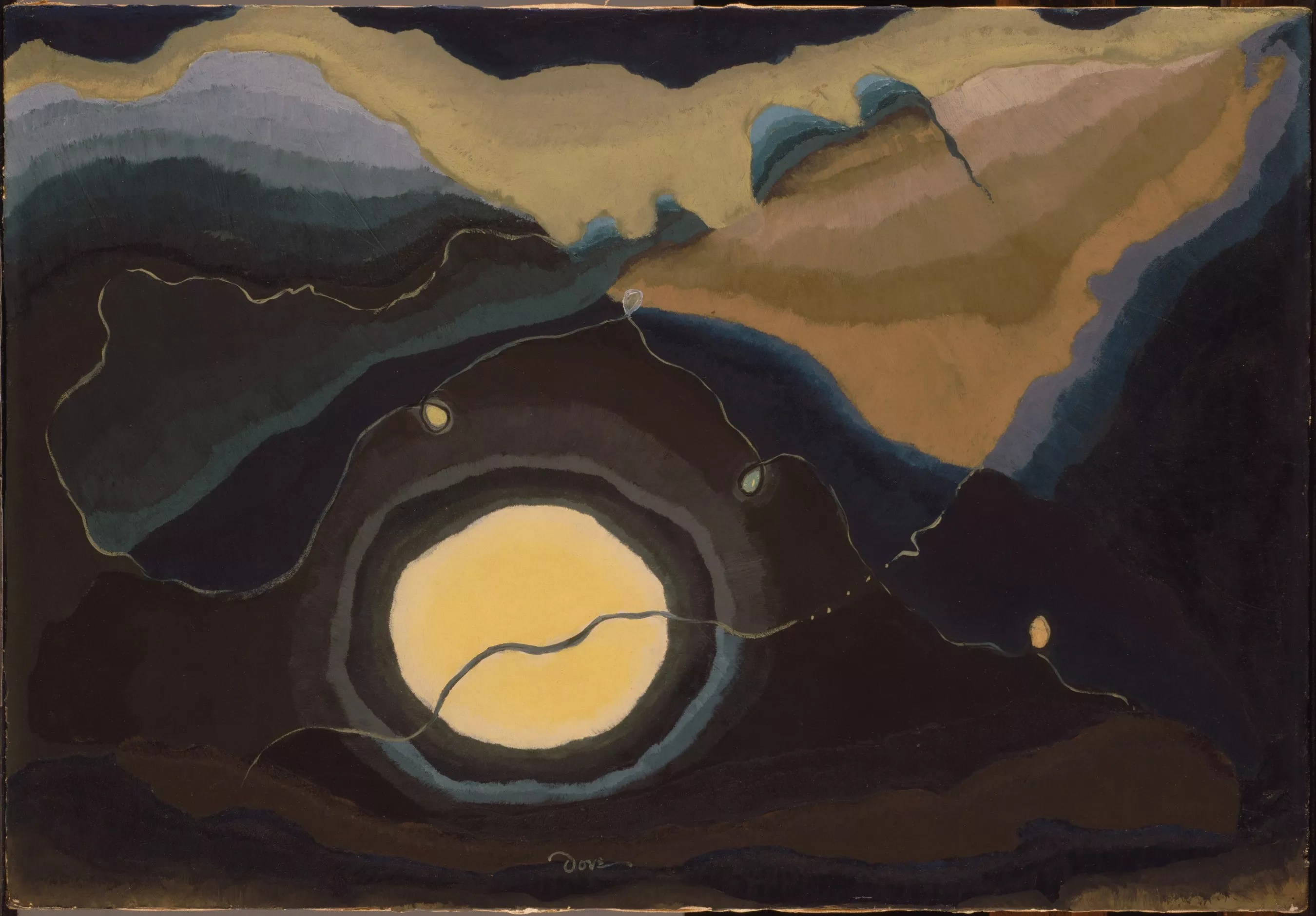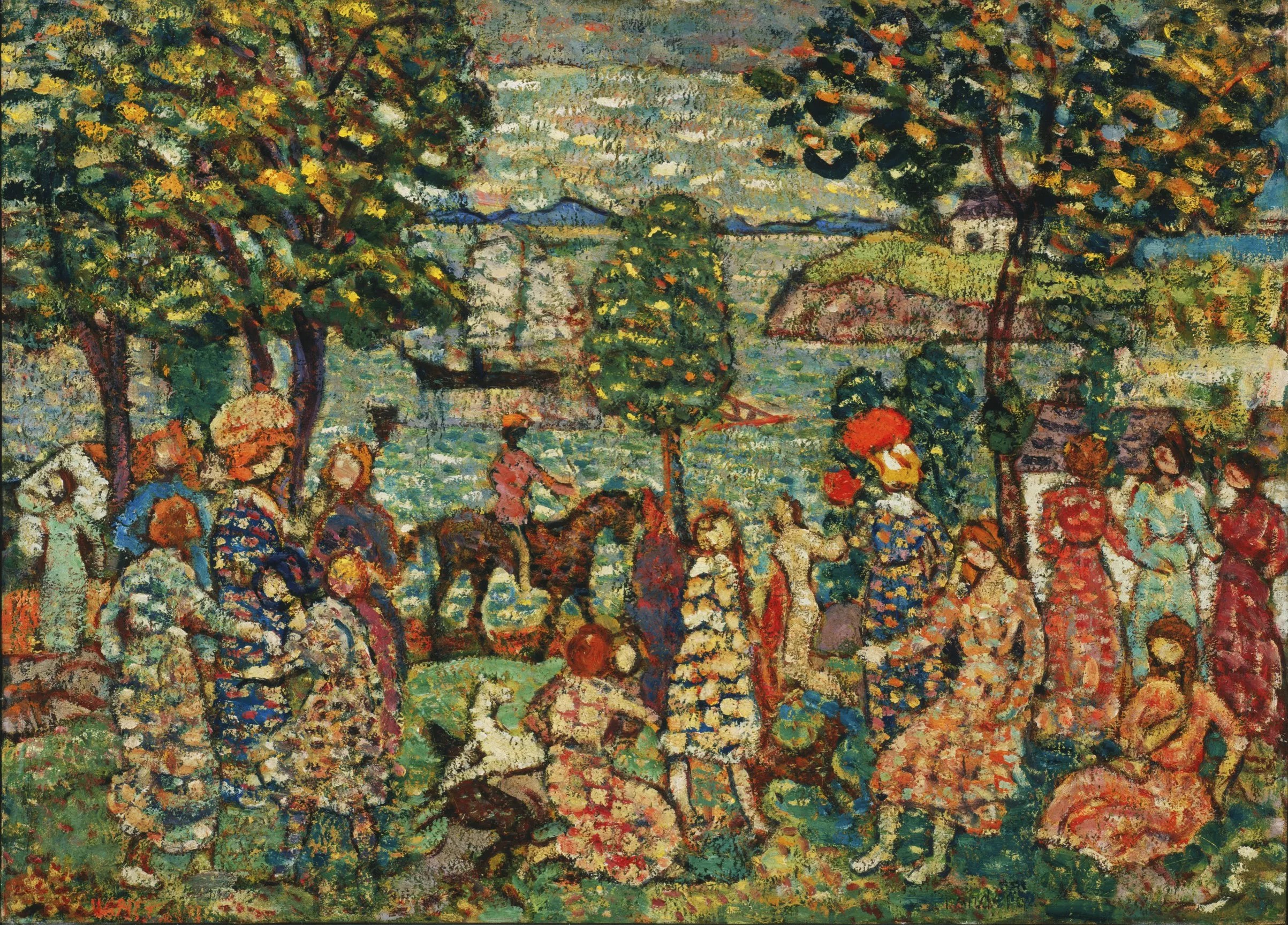
Courtesy of the Denver Art Museum

Audio By Carbonatix
After lowering the needle on a John Coltrane record, Sam Gilliam followed his usual creative process in his Washington, D.C., studio. It was 1967, and as Coltrane’s rhythms filled the room, Gilliam carefully poured paint onto a large canvas, then folded it up, allowing the colors to move where they would, before hanging it on the wall. The color-field artist had said that “jazz leads to the acrobatics of art,” and there it was: The cadmium-red organic shape appeared to flare like a flower from a soft background of violet and cobalt, ochre and vermillion green; it was as though Coltrane’s harmonies had come to life. Gilliam titled the work “Red Petals.” It would be shown at his very first museum exhibition that year, at the Phillips Collection in D.C.
Now, “Red Petals” is welcoming visitors into the Denver Art Museum‘s exhibition All Stars: American Artists From the Phillips Collection, on view through March 3. It’s a revelatory show, reflecting the diversity of the Phillips Collection and the effort that its founder, Duncan Phillips, and his wife, artist Marjorie Acker, aimed at supporting new, upcoming artists. At the age of thirty, Phillips and his brother were each given a yearly stipend of $10,000 to collect art by their millionaire father. After his father and brother died, Phillips and his mother founded the Phillips Collection in 1921, and he used the museum not only to show his stock of paintings by El Greco, Goya, Gauguin, Cézanne, Manet and Matisse, but to support up-and-coming artists: Georgia O’Keeffe, John Marin, Nicolas de StaÁ«l, Arthur Dove and many more, all of whose works are now on view at the DAM.
“The Denver Art Museum decided to work with the Phillips Collection for a multitude of reasons – one being that the Phillips Collection is significant for its celebration of the best American art,” says DAM curatorial assistant Hadia Shaikh. “All Stars: American Artists From the Phillips Collection features 75 masterworks by 56 iconic American artists, including 21st-century artists and new voices that explore important issues of today. The Denver Art Museum really values how the Phillips Collection actively amplifies American art and artists who follow a unique vision.”

Janet Taylor Pickett, And She was Born, 2017
Denver Art Museum
Curated by Rory Padeken, DAM’s curator of modern and contemporary art, All Stars doesn’t just showcase splendid works; it emulates Phillips’s curatorial ethos. The Phillips Collection, which celebrated its 100th anniversary three years ago, is an eclectic wonder. Located in a brick Georgian Revival building by bustling Dupont Circle, it comprises such works as Renoir’s “Luncheon of the Boating Party,” hanging in the vicinity of a wholeheartedly abstract Motherwell or Pollock. Considered the United States’ first modern art museum, the collection spans Impressionism, Abstract Expressionism, Bauhaus, Futurism, Minimalism, Surrealism and more.
Phillips himself didn’t care for the “-isms” of art – labels that pigeonholed exhibitions, museums and artists into following specific styles and traditions. His museum became known for its eccentricity; he never hung paintings chronologically or by genre, but by their more intrinsic relations. He liked to show opposing styles alongside each other to encourage viewers to consider not just the look of the paintings, but the similarities or differences between artists’ interpretations of related subjects or scenes. He believed a Hopper or Gauguin looked just as fine, or even complementary, when hung by an African mask or Brancusi sculpture, and that figurative paintings could be, should be, placed alongside abstract ones. According to an essay by former Phillips director Dorothy Kosinski ahead of the museum’s centennial, Phillips once explained that he composed such “arrangements for the purpose of contrast and analogy,” something that exposed “unity in diversity.”
All Stars follows Phillips’s curatorial direction, with each room a symphony of varying styles, colors, explorations and concepts. From more traditional landscapes or portraits by Edward Hopper to massive abstract studies by Richard Diebenkorn, the show includes some of the most innovative artists of their time and imbues visitors with Phillips’s philosophy of seeing as an artist sees – which, as the show exemplifies, is never the same from one artist to another.
“Phillips…did not collect art in terms of art historical movements or artistic style, but shared interest of the artists, such as artists responding to the human condition and their role in our lives,” explains Shaikh, noting that the seven rooms in the show are each inspired by Phillips’s own writings.

Georgia O’Keeffe, “Large Dark Red Leaves on White, 1925.”
Denver Art Museum
As visitors meander through the rooms, the “shared interest of the artists” described by Shaikh is made clear. Artists whose styles are quite distinct still pulled inspiration from one another. Georgia O’Keeffe was a more literary painter, but the emphatically abstract John Dove (a favorite of Phillips, as evidenced by the multiple canvases shown) said she was “doing without effort what all we moderns have been trying to do.” This is an interesting comment, considering that O’Keeffe drew more figurative paintings, albeit notable for their double entendres: The beautiful “Large Dark Red Leaves on White” indeed comprises leaves, but also could be a vagina. While O’Keeffe looked outwardly to reflect the internal – “My Shanty, Lake George” is a landscape, but also considered a self-portrait – Dove went inward, eschewing the traditional landscapes for compositions that spilled from his own imagination but were still inspired by the natural world that enchanted O’Keeffe.

Athur Dove’s “Me and the Moon.”
Denver Art Museum
There are also the nested squares in a work by Josef Albers, who refused to paint much else since starting his series Homage to the Square in the early ’50s but reveled in the color theory they espoused. This series enraged more traditional aesthetes of the time, who believed Albers was playing some sort of joke: Would wealthy collectors really fall for this, paying boatloads for simple squares? But Albers, as well as fellow geometric abstractionists, was heavily boosted by art critics of the time, such as Clement Greenberg, who argued that underlying theory was the element that made a painting artful rather than the image itself. Because Albers wasn’t just painting squares; he was “inviting meditation on the psychology of perception, visual experience and ultimately the interaction between the work of art and its viewer,” according to the DAM’s wall plaque next to “Homage to the Square: Temprano” (1957), an “experience” confined by teal, gray, periwinkle and cream. Who knew squares could be so powerful, even transformational?
Apparently Jacob Lawrence was transformed; he said that Albers, with whom he worked, “had a great influence on me in a plastic, aesthetic sense.” Lawrence used that plasticity in a far more emotive way, however, with his Migration Series, an epic collection of sixty works of casein paint on hardboard that the artist painted simultaneously, using one color at a time on each board. After the series was completed in 1941, the Phillips and New York’s Museum of Modern Art acquired the works, with MoMA taking even-numbered panels and the odd numbers going to the Phillips. The panels explore the post-WWI migration of Black Americans from the South to the North, where they were still confronted with segregation and racism. The devastating images are as simplistic in color as Albers’s squares but supply a weightier punch, especially with the titles that Lawrence wrote. “African Americans seeking to find better housing attempted to move into new areas. This resulted in the bombing of their new homes” shows a housing project ablaze, with freshly tossed bombs flaring over broken windows. Only one window gleams yellow – calling attention to someone still in the building.

Jacob Lawrence’s third panel of his Migration Series, from 1940.
Denver Art Museum
Such enigmatic storytelling is found in every room at All Stars, thanks to Phillips’s keen collector’s eye. And after his death in 1966, his museum’s curators maintained his mission of supporting newer artists. There’s Los Angeles-based Aaron Maier-Carretero, whose large oil painting “not in front of the kids” is a jarring confrontation of domestic abuse, love and tension in home life, and Janet Taylor Pickett’s “And She Was Born,” a powerful portrait of an Ethiopian woman donning fruits and flowers on her head. Clyfford Still, whose self-titled museum is in Denver, was another burgeoning artist Phillips collected (even as Still insisted the art world was his “enemy,” it sure helped his career). Still meant to evoke the booming crescendos of Beethoven in his Phillips piece displayed at the DAM; the painting, an erratic chasm of black paint punctured by a glowing orange circle, is fierce on the eyes – easier to look away from than at.

Maurice Brazil Prendergast’s “Fantasy.”
Denver Art Museum
But the show’s variety is what makes it an outing fit for all, even those who believe they dislike “modern art.” People who love Impressionism (who doesn’t?) will find themselves pulled to “Fantasy,” by Maurice Prendergast, a thickly impastoed scene of a jubilant, seaside picnic, or to Ernest Lawson’s “Spring Night, Harlem River,” a Monet-inspired take on the Washington Bridge. Meanwhile, those who marvel at abstraction will be swept away by the fantastic scenes by Helen Frankenthaler, Adolph Gottleib, John Marin, Robert Motherwell and, of course, Jack the Dripper (Pollock).
Most of all, there are the enchanting paintings by Edward Hopper: “Sunday,” which shows a man sitting on a curb in the morning light, his arms folded in a contrast of emotion and beauty, as well as “Approaching a City,” a view from within a train of railroad tracks approaching a tunnel. That work is almost abstract in its own right, as steeped in theory as Albers’s. Hopper isn’t simply portraying a landscape or creating a pretty composition. He is contemplating an arrested moment in travel, just before passing from the outward light through a dark tunnel and out again. The future is being dangled, and viewers are compelled to consider their own trajectory.
“Art is a universal language which defies classification,” Phillips once said. “I teach the universality of art as a unifying spirit and the continuity of human thought and aspiration.” Lesson learned.

Aaron Maier-Carretero’s “not in front of the kids.”
Denver Art Museum
All Stars is on view through March 3 at the Denver Art Museum, 100 West 14th Avenue Parkway. Tickets are available at denverartmuseum.org.